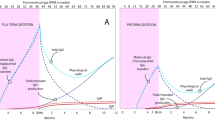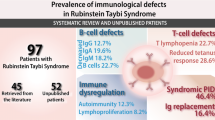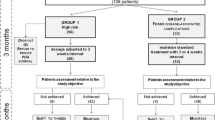Abstract
Purpose
Infants with recurrent infection may be found to have hypogammaglobulinemia without impaired specific antibody responses. Many will be diagnosed with transient hypogammaglobulinemia of infancy.
Methods
This study used a parametric survival analysis of 100 infants with hypogammaglobulinemia to predict time to normalization.
Results
Aggregate initial immunoglobulins (IgG + IgA + IgM), as a percentage of age-adjusted normal, predicted time to resolution: median time to resolution for the infants in the lowest quartile of aggregate levels (≤81 % of age-adjusted lower limits) was greater than 5 years, with 34 % resolving in 3 years. For infants in the highest quartile (≥130 % of age-adjusted lower limits), the median was 9.9 months, with 77 % resolving in 3 years (P = 0.008). Initial IgG level, as a percentage of age-adjusted normal, also predicted resolution: the median time in the lowest quartile (≤78 % of age-adjusted lower limits) was greater than 5 years, with 36 % resolving in 3 years. In the highest quartile (≥128 %), the median time was 14.5 months, with 70 % resolving in 3 years (P = 0.010). Male sex was associated with more rapid resolution. The median time in males was 13 months, with 73 % resolution in 3 years. The median time in females was greater than 5 years, with 32 % resolution in 3 years.
Conclusions
These results suggest that if a term infant presents with hypogammaglobulinemia, protective specific antibody titers, and an absence of other known immune deficiency, initial immunoglobulin levels and sex may predict time to normalization.





Similar content being viewed by others
References
Al-Herz W, Bousfiha A, Casanova JL, Chapel H, et al. Primary immunodeficiency diseases: an update on the classification from the international union of immunological societies expert committee for primary immunodeficiency. Front Immunol. 2011;2:54–5.
Horwitz A, Kung SJ, McGeady SJ. Infants with low immunoglobulin levels: isolated low IgA level vs other immunoglobulin abnormalities. Ann Allergy Asthma Immunol. 2010;105:295–8.
Kowalczyk D, Baran J, Webster AD, Zembala M. Intracellular cytokine production by Th1/Th2 lymphocytes and monocytes of children with symptomatic transient hypogammaglobulinaemia of infancy (THI) and selective IgA deficiency (SIgAD). Clin Exp Immunol. 2002;127:507–12.
Siegel RL, Issekutz T, Schwaber J, Rosen FS, Geha RS. Deficiency of T helper cells in transient hypogammaglobulinemia of infancy. N Engl J Med. 1981;305:1307–13.
Rutkowska M, Lenart M, Bukowska-Strakova K, et al. The number of circulating CD4+ CD25high Foxp3+ T lymphocytes is transiently elevated in the early childhood of transient hypogammaglobulinemia of infancy patients. Clin Immunol. 2011;140:307–10.
McGeady SJ. Transient hypogammaglobulinemia of infancy: need to reconsider name and definition. J Pediatr. 1987;110:47–50.
Moschese V, Graziani S, Avanzini MA, et al. A prospective study on children with initial diagnosis of transient hypogammaglobulinemia of infancy: results from the Italian Primary Immunodeficiency Network. Int J Immunopathol Pharmacol. 2008;21:343–52.
Whelan MA, Hwan WH, Beausoleil J, Hauck WW, McGeady SJ. Infants presenting with recurrent infections and low immunoglobulins: characteristics and analysis of normalization. J Clin Immunol. 2006;26:7–11.
Buckley RH, Dees SC, O’Fallon WM. Serum immunoglobulins: I levels in normal children and in uncomplicated childhood allergy. Pediatrics. 1968;41:600–11.
Karaca NE, Aksu G, Gulez N, Yildiz B, et al. New laboratory findings in Turkish patients with transient hypogammaglobulinemia of infancy. Iran J Allergy Asthma Immunol. 2010;9:237–43.
Keles S, Artac H, Kara R, Gokturk B, Ozen A, Reisli I. Transient hypogammaglobulinemia and unclassified hypogammaglobulinemia: 'similarities and differences'. Pediatr Allergy Immunol. 2010;21:843–51.
Qian JH, Zhu JX, Zhu XD, Chen TX. Clinical features and follow-up of Chinese patients with symptomatic hypogammaglobulinemia in infancy. Chin Med J (Engl). 2009;122:1877–83.
Acknowledgments
The authors thank Christopher C. Chang, MD, PhD, for his ideas regarding established normal values of immunoglobulins.
Conflicts of interest
The authors have no conflicts of interest to declare.
Author information
Authors and Affiliations
Corresponding author
Rights and permissions
About this article
Cite this article
Van Winkle, R.C., Hauck, W.W. & McGeady, S.J. Phenotypic Parameters Predict Time to Normalization in Infants with Hypogammaglobulinemia. J Clin Immunol 33, 1336–1340 (2013). https://doi.org/10.1007/s10875-013-9937-7
Received:
Accepted:
Published:
Issue Date:
DOI: https://doi.org/10.1007/s10875-013-9937-7




